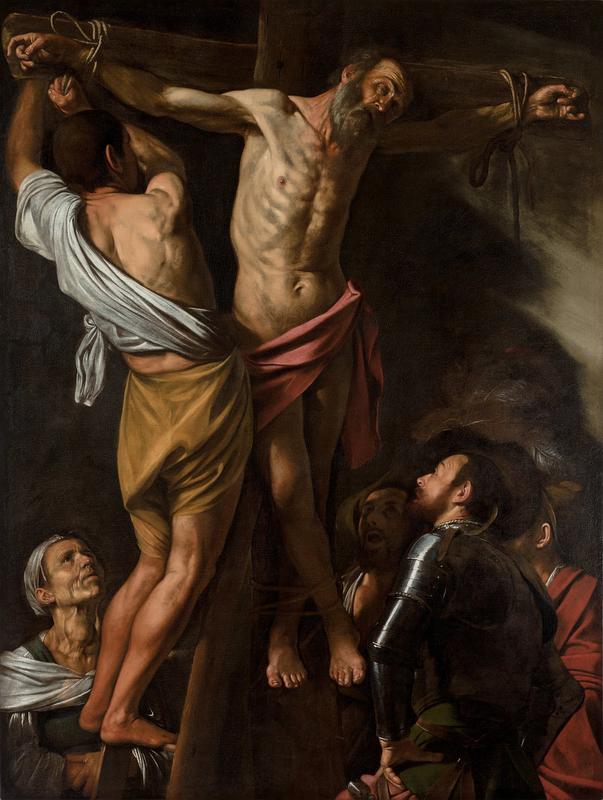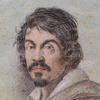More about The Crucifixion of Saint Andrew
- All
- Info
- Shop

Contributor
The Crucifixion of Saint Andrew is a painting by Caravaggio in the tradition of the veneration of saints common to Catholicism and Christian Orthodoxy.
"Worship," like "cult," can be an ambiguous word, so Catholic and Orthodox adherents use two Greek words to describe the distinction between the forms of honor for saint, and for tributes to the Holy Trinity. The Trinity's worship is latria, and is less ritualistic, while proskynesis is dedicated to angels, relics, icons, and figures like Saint Andrew. Andrew's name was Andreas, meaning "manhood" or "honor" in Greek, which is unusual, because Christian tradition holds that he was the brother of the apostle Peter, whose Hebrew name (Simeon) is well attested, but Andreas seems not to have had a Hebrew name at all. The armored man in this painting is Egeas, proconsul of the Roman empire, who makes a cameo in another Caravaggio painting maintained by the Kunsthistorisches Museum Vienna.
As you can see in the lower portion of this work, Caravaggio follows a storytelling tradition that developed in medieval Europe, showing Andreas's cross in a different shape, that of an X, which they call the crux decussata. This version is so popular that it is the form of the national flag of Scotland. The story of Andreas, as recorded in the Acts of Andrew, is apocryphal, meaning that church authorities, for the last 1,800 years or so, consider it about as authoritative as college professors consider TMZ. For some set of reasons, church patriarchs voted it off the island within a few hundred years. This redaction didn't laminate the stories into one version, as the patriarchs hoped, but seems to have done the opposite. For instance, the early Acts of Andrew attested by Gallo-Roman historian Gregory of Tours describes Andreas bound to a cross, as Caravaggio shows, but claims that it was a typical Latin cross, of the form that appears in churches, not a crux decussata.
There are three existing copies of this work, two of which are by Caravaggio's hand. This painting was once owned by Juan Alonso Pimentel de Herrera, Viceroy of Naples, a Knight of the Order of Santiago, Grandee of Spain, 5th Duke of Benavente.
Sources
- Brancato, Francesca. "LA “CROCIFISSIONE DI S. ANDREA” A SIRACUSA, MA È SOLO UNA COPIA." Notabilis, Apr. 9, 2019, https://www.notabilis.it/articolo/2019/4/9/la-crocifissione-di-s-andrea….
- Carlson, David Richard. John Gower, Poetry and Propaganda in Fourteenth-century England. Cambridge: DS Brewer, 2012.
- Johnson, Kevin Orlin. Why Do Catholics Do That?: A Guide to the Teachings and Practices of the Catholic Church. New York: Random House, 2011.
- Marlow, Tim. "Caravaggio & Bernini at the Kunsthistorisches Museum." Sotheby's, https://www.sothebys.com/en/videos/sotheby-s-mms38-v1b-caravaggio.
- Martin, Samantha De. "DALLA CROCIFISSIONE DI SANT'ANDREA, PER LA PRIMA VOLTA IN ITALIA, AL VIAGGIO IN SICILIA: SIRACUSA OMAGGIA CARAVAGGIO." Arte.it, Apr. 23, 2019, http://www.arte.it/notizie/siracusa/dalla-crocifissione-di-sant-andrea-…-
- Mastromattei, Dario. "Crocifissione di sant’Andrea di Caravaggio: il teatrale martirio dell’apostolo." Arteworld, Sep. 4, 2017, https://www.arteworld.it/crocifissione-san-andrea-caravaggio-analisi/.
- Réau, Louis. Iconographie de l'art chrétien: Iconographie des saints. 3 v. Paris: Presses universitaires de France, 1959.
Featured Content
Here is what Wikipedia says about The Crucifixion of Saint Andrew (Caravaggio)
The Crucifixion of Saint Andrew (1607) is a painting by the Italian Baroque master Caravaggio. It is in the collection of the Cleveland Museum of Art, which acquired it from the Arnaiz collection in Madrid in 1976, having been taken to Spain by the Spanish Viceroy of Naples in 1610.
The incident depicted, the martyrdom of Saint Andrew, was supposed to have taken place in Patras, Greece. The saint, bound to the cross with ropes, was said to have survived two days, preaching to the crowd and eventually converting them so that they demanded his release. When the Roman Proconsul Aegeas—depicted lower right—ordered him taken down, his men were struck by a miraculous paralysis, in answer to the saint's prayer that he be allowed to undergo martyrdom.
From the 17th century Saint Andrew was shown on a diagonal cross, but Caravaggio would have been influenced by the 16th century belief that he was crucified on a normal Latin cross.
Check out the full Wikipedia article about The Crucifixion of Saint Andrew (Caravaggio)













